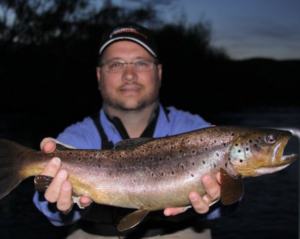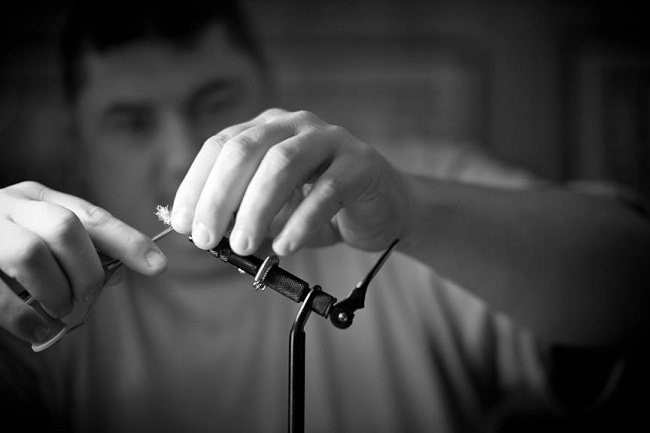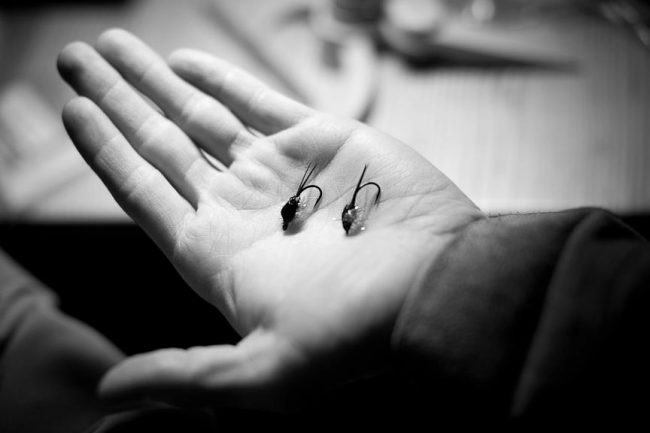NEWS & STORIES
Fly-Tying versus Psychogenic Tremor

Photo Courtesy of REEL Healing
Bill Alexander, Ph.D., MS, LPC is a Licensed Professional Counselor, Adjunct Professor of Psychology at Tarleton State University (Texas), and manager of a scholarship program at Weatherford College (Texas). He is also a research psychologist with published works on the efficacies of Nature-Assisted Therapy and Therapeutic Fly-Fishing in Veterans suffering from trauma-related symptomology. Additionally, Dr. Alexander owns a Counseling Services Center in Texas with an emphasis of service to veterans. Dr. Alexander also volunteers regularly with the PHWFF North Texas Program at the Fort Worth (Texas) Veterans Affairs Medical Clinic. He wrote the article below with the purpose of helping others.
The purpose of this article is to examine the effects of fly-tying as a therapeutic intervention for Psychogenic Tremor (PT) in a single case study. PT, also called functional tremor, can appear as any form of tremor. Its symptoms may vary but often start abruptly and may affect all body parts. The tremor increases in times of stress and decreases or disappears when distracted. Many individuals with psychogenic tremor have an underlying psychiatric disorder such as depression or post traumatic stress disorder.
While volunteering my services at the Fort Worth (Texas) Veterans Affairs Medical Clinic with Project Healing Waters, North Texas Chapter under the lead of Johnny Walker, and lead volunteer, Jeff Guinn, I was teaching wounded, disabled, and sick veterans how to tie flies—associated with fly-fishing. While working with another veteran, teaching him how to tie flies, a veteran in an electric wheelchair approached our table and asked what we were doing. I told the gentleman that we were teaching veterans how to tie flies, and I asked if he would like to participate. The gentleman in the wheel chair stated that he could not tie flies with us because he suffered from tremors; however, he wanted to watch. After I finished with the veteran I was tying flies with, Jeff Guinn suggested to the veteran in the wheelchair that tying flies taps into the part of the brain that triggers focus; thereby, reducing tremors and that he (the veteran) should try. Reluctantly, the veteran in the wheelchair decided to try. I showed the veteran (on a separate vice) how to begin tying in thread onto the hook shank. The veteran began to layer the thread on his hook shank (on a separate vice), and almost immediately experienced a tremor in his hands, which broke the thread off of the hook and bobbin. I observed the veteran’s frustration, and I told him that it was ok and that I broke thread all the time. I prepared his thread bobbin again, and he proceeded to wrap thread on the hook shank again—this time, without any tremors. I continued to show the veteran how to tie the particular fly we were tying, explaining the “how’s” and “why’s” in the procedures and the therapeutic value of fly-tying and fly-fishing, in general. We finished the fly after 30-minutes of instruction, and the veteran took his “new” fly out of the vice and marveled at what he had just created. It was then I noticed he had another tremor, almost dropping the fly, while he was looking at it. The veteran then looked at me in amazement, and said that he tied his fly without having any tremors beyond the initial tremor at the start. Needless to say, he was excited about (I assume) the possibility that increased focus on specific activities would temporarily alleviate his symptoms of tremors in his hands. It was clear to Jeff Guinn and me that we provided hope for a fallen brother in his diagnosis and treatment options for his disability, and we could not be happier in the fruits of our labor. To see a veterans go from darkness to light—from the depths of despair to the heights of hope was inspirational. We are in awe, but we really shouldn’t be. Research suggests it, and evidence supports it. Project Healing Waters, North Texas Chapter continues to do incredible work with veterans and results in incredible works for our brothers and sisters.
Graciously, Humbly, and Respectfully,
Bill Alexander, Ph.D.
Licensed Professional Counselor

